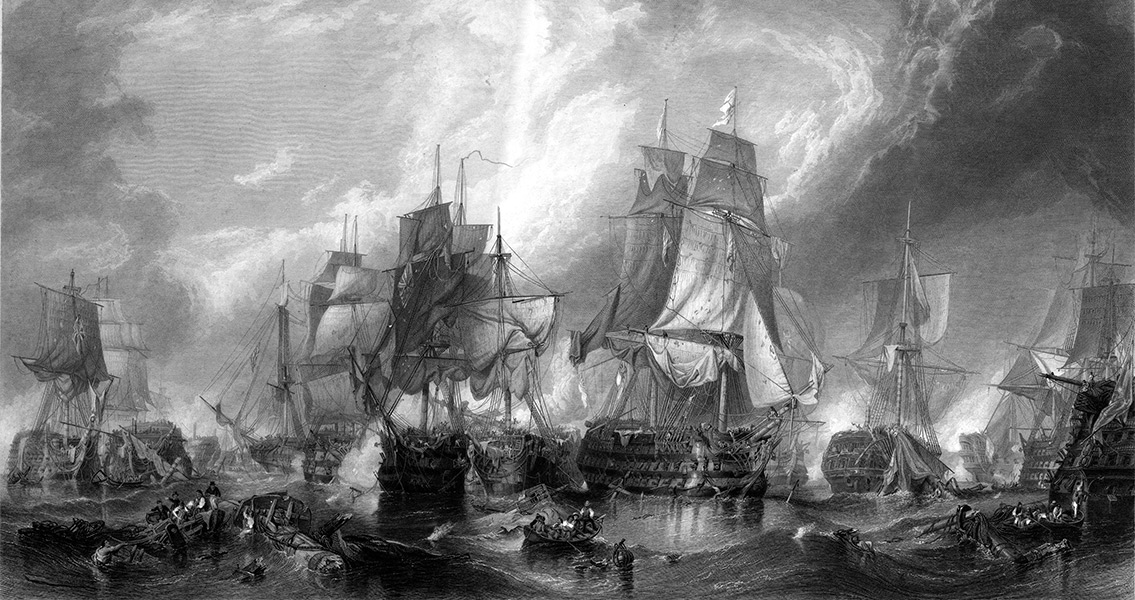<![CDATA[Immortalised in the architecture of London, the Battle of Trafalgar took place 210 years ago, on 21st October, 1805. Like the Battle of Waterloo a decade later, the events of 1805 have become defining moments in British history. Trafalgar Square, and Nelson's Column, two of London's most distinguishing landmarks, were both created in connection to the British victory off of the coast of Spain in October 1805. The monuments, and the battle itself, provide a unique insight into Britain two centuries ago. In 1805 there was a very real sense that the country was under threat of invasion from the French. War between Britain and France had raged since 1803, and a substantial French army had been prepared in Calais, providing an ominous threat to Britain's security. As a result, the British victory at Trafalgar is often portrayed as a defiant triumph against French aggression. Vice Admiral Nelson's victory, one which ultimately cost him his life, didn't defeat Napoleon outright, that wouldn't come until the Battle of Waterloo a decade later; but it did remove the threat of a land invasion by devastating the French Navy. Beneath this romantic, heroic narrative, there is of course a more complicated story. Napoleon's war with Britain was the result of combination of factors, but can be broken down into the same colonial rivalry between great European powers that triggered so many conflicts in the nineteenth century. By ensuring its survival, and harming its enemies, Britain also ensured its continuation as the dominant imperial power in Europe, laying the foundations for its commercial empire across the globe. As such, monuments such as Nelson's Column or Trafalgar Square are just as much marks of Britain's imperial history as they are of the country withstanding the onslaught of Napoleon's armies. The story of the battle itself is well known. By allying with Spain in 1804, France had gained the ships necessary to challenge the British Navy. In 1805, the massive fleet of French Admiral Pierre-Charles Villeneuve broke out from its safe haven in Toulon and into the Atlantic Ocean. The British Navy, commanded by Nelson, chased the French fleet down, all the way to the West Indies, to force it away from the British Isles. In September 1805, Villeneuve's fleet made its way to Cadiz, off of the coast of Spain. Suddenly, the massive force was in an ideal location to launch an attack on British trade in the Atlantic, or the country itself. In response, Nelson abandoned his previously defensive strategy, deciding that the French fleet had to be annihliated. The British and French fleets engaged each other on the 21st October. Nelson's plan had the British fleet divide in two, the first wave attacked the French flagship, neutralising it and leaving the French forces in chaos. A second wave then arrived to attack the rest of the disorientated French fleet. The strategy was risky, even though the British ships outnumbered the French. After five hours of fighting, nineteen French ships had been sunk, while all of the British ships survived. 1,500 British seamen were killed however, among them Nelson himself, who was shot by a French sniper. The Battle of Trafalgar was a vital victory for Britain, one which many historians have argued was key in forming a national identity. It is important to remember however, that the victory was as much a triumph of British imperialism, and all the controversies that went with it, as it was one of heroic defiance against Napoleonic aggression.]]>
The Battle of Trafalgar – Architecture and Imperialism
